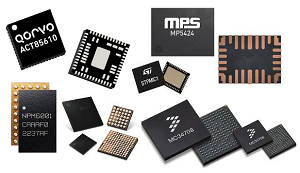Active Products Parts:
Power Management Integrated Circuits (PMICs)
What Are Power Management ICs?
 While electricity from a wall outlet in your home typically provides 120V alternating current (AC) in the US, not all components within home appliances can use this AC power directly. These appliances first convert the 120V AC to direct current (DC) to supply the various electronic circuits they contain. Each circuit has its own specific power requirements, and Power Management ICs (PMICs) ensure stable voltage supply to meet these needs.
While electricity from a wall outlet in your home typically provides 120V alternating current (AC) in the US, not all components within home appliances can use this AC power directly. These appliances first convert the 120V AC to direct current (DC) to supply the various electronic circuits they contain. Each circuit has its own specific power requirements, and Power Management ICs (PMICs) ensure stable voltage supply to meet these needs.
Power management ICs and power modules form the backbone of powering today's and tomorrow's innovations across various markets. These high-performance power management solutions meet stringent power requirements through advanced design and packaging technologies, offering unparalleled power densities, ultralow noise, and exceptional reliability. These features ensure systems operate at optimal efficiency, speed, and power levels, while enhancing feature density and reducing ownership costs.
Embedded and application processors in complex systems often require multiple power rails and domains. Using discrete devices for power management in such systems can be both expensive and inefficient. PMICs integrate multiple voltage regulators and control circuits into a single chip, providing a comprehensive power supply solution that reduces component count and saves board space, while effectively managing system power at a lower cost.
PMICs are ideal for embedded processing across a variety of applications, including:
- Internet of Things (IoT)
- Edge computing
- Medical and Industrial IoT
- Electric Vehicles (EVs) and autonomous vehicles
- System on Modules (SOMs) combining PMICs with industrial-grade microprocessors (MPUs)
By incorporating PMICs, developers can simplify their designs and accelerate time to market.
Advantages of Designing with Integrated Power Management ICs
- Simplifies power management in complex embedded systems
- Provides efficient power supplies for processing systems
- Optimizes power consumption and extends battery life
- Controls complex power systems effectively
- Reduces circuit board space requirements
- Accelerates time to market and minimizes risk
- Lowers engineering and sourcing effort
Roles of Power Management ICs
Power Management ICs (PMICs) play crucial roles in ensuring the efficient and stable operation of electronic devices. They include three main types: regulators, reset ICs (voltage detectors), and switch ICs. These components are vital for maintaining the functionality and efficiency of modern electronic systems.
-
Regulators Regulators provide stable source voltage and power according to the requirements of each device. This category includes linear regulators and DC/DC converters.
For example, a fully charged Li-ion battery in mobile phones or smartphones supplies about 4.2V. However, the phone's processor typically requires only about 1.2V to operate properly. Excess voltage can damage the processor. As the battery's voltage diminishes over time and with each charge cycle, regulators convert the varying battery voltage into a stable 1.2V, ensuring the processor operates safely and efficiently. Regulators maintain a consistent output voltage despite input fluctuations, provided the battery voltage remains within their operating range.
-
Voltage Detectors (Reset ICs) Each device has a specific operating supply voltage range. If the supply voltage falls outside this range, the device may malfunction and must be stopped. Even after the voltage returns to normal, the device might not function correctly without being reset. During system startup, the internal state can be unstable, necessitating a reset.
Reset ICs, or voltage supervisor ICs, monitor the supply voltage and output a reset signal when the voltage falls outside the acceptable range. This reset signal stops the device and allows it to initialize its internal state to the preset condition, ensuring proper operation upon restarting. Voltage supervisor ICs are mainly used to reset load devices and are thus commonly called reset ICs.
-
Switch ICs Switch ICs control the power supply by turning it on or off in the power line. When multiple devices share a power line of the same voltage, switch ICs can selectively turn the power on or off for each device based on its state, thereby reducing overall power consumption. These are often referred to as load switch ICs when used in this manner.
By integrating these three types of PMICs, electronic devices can achieve enhanced efficiency, stability, and longevity, contributing to the advancement of modern technology and economical operation.
In addition to our franchise lines we actively stock and order parts from the following manufacturers:
- Allegro MicroSystems
- Analog Devices Inc.
- Broadcom Limited
- Diodes Incorporated
- DIOO
- GigaDevice
- Infineon
- IXYS
- Littelfuse
- MACOM
- Microchip
- Mitsubishi Electric
- Monolithic Power Systems (MPS)
- Nisshinbo Micro Devices
- NXP
- onsemi
- Power Integrations
- Renesas Electronics
- Richtek
- ROHM Semiconductor
- Semtech
- Shindengen
- Skyworks
- STMicroelectronics
- Tamura
- Texas Instruments
- Toshiba
- Vishay
- Wolfspeed